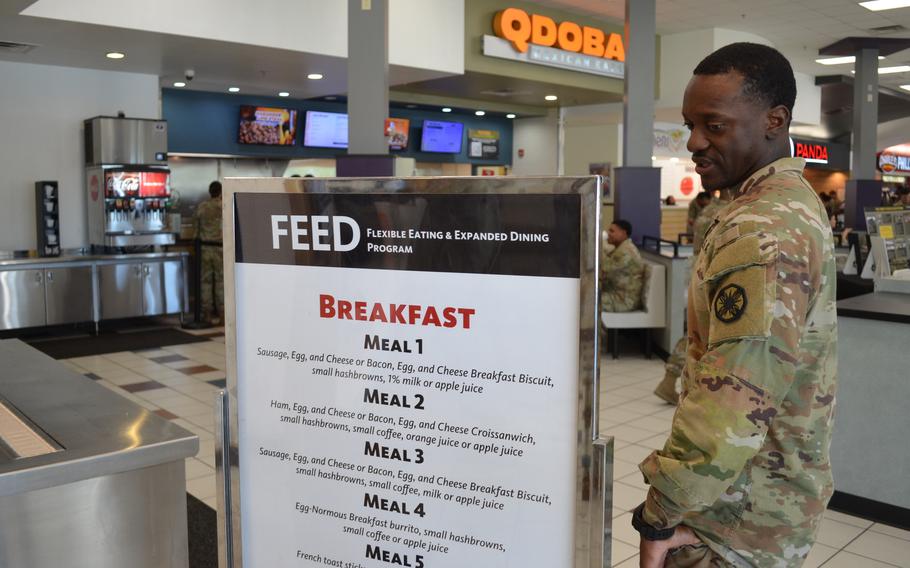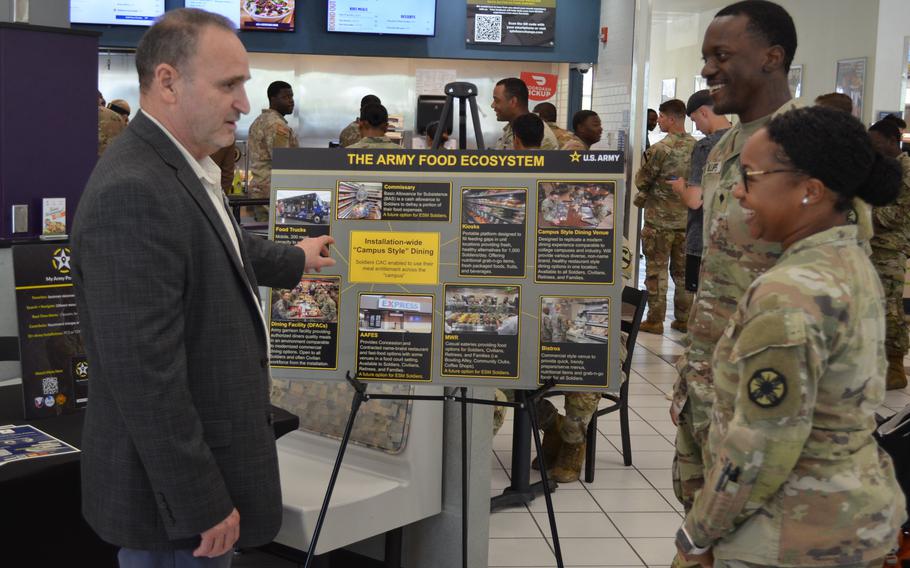
Army Spc. Ceri Phillips reviews meal options for purchase at Burger King through a meal entitlement pilot program at Fort Hood, Texas, on Aug. 14, 2025. (Rose L. Thayer/Stars and Stripes)
FORT HOOD, Texas — The Army for the first time this week granted 200 soldiers the power to use their military ID card to buy food outside of the dining facility with their meal entitlements.
For the next two weeks, the soldiers can visit participating restaurants at Fort Hood and swipe their ID cards as payment. The concept seems basic and ordinary, but as far as Army dining is concerned it is a groundbreaking step toward dining options that soldiers have long requested.
Spc. Ceri Phillips, a soldier in the pilot program, said the short hours at dining facilities make it difficult for him to get there before they close. As a fueler, there are times when he gets stuck in the motor pool later than expected.
“When you do get out and go to the [dining facility], you only have that certain amount of time left and what they have left that you have to choose from,” he said.
The restaurants stay open later, and the offerings aren’t diminished by the end of the day, Phillips said.
Rick Bennett, senior logistics management specialist in Army Materiel Command’s Army Food Innovation and Transformation Division, said Phillips’ feedback is exactly what they were hoping to hear.
“We wanted to give them a variety of menu choices and capabilities and allow the soldiers to explore with it,” he said.
The Army has been working on ways to improve soldier access to food on bases using their meal entitlements as eating in dining facilities has dropped over time, which has been driven by changes in soldiers’ meal preferences and fewer cooks being enlisted to work in the facilities.

Rick Bennett, senior logistics management specialist in Army Materiel Command’s Army Food Innovation and Transformation Division, speaks Aug. 14, 2025, with Spc. Ceri Phillips and Pfc. Renee Myatt about a meal entitlement pilot program at Fort Hood, Texas. (Rose L. Thayer/Stars and Stripes)
Each month, a portion of soldiers’ paychecks is set aside to use for meal entitlements and the dining facility has been the only place to spend that money. To expand use of those entitlements, the Army has been working to innovate and overhaul its food programs through several initiatives such as this pilot program. It is also looking at how to allow soldiers to shop with the entitlement at the commissary, Bennett said.
This pilot program that opens access to certain restaurants that operate on installations through the Army and Air Force Exchange Service is the first of its kind and has been at the top of soldiers’ requests for a while, Bennett said.
Primarily, soldiers want options that are fast and open beyond the 90-minute meal windows that traditional dining facilities offer.
Pfc. Renee Myatt, a driver who is also in school, said the expanded hours make a huge difference in her ability to use her meal entitlements.
“Once I’m done with work, I need a quick and easy meal to go. I don’t want to be waiting in a [dining facility] line,” she said. “It’s quick, simple and easy for me.”
In the first three days of the two-week program, 111 soldiers bought 324 meals, Bennett said. At the end of the trial run, he said they plan to review how it worked and whether there is an opportunity to reopen and expand access. What that looks like and when is up to Army leaders, Bennett said.
“When soldiers pass up that benefit and that entitlement every single day, we fail them,” said Lt. Gen. Chris Mohan, acting commander of Army Materiel Command, which is responsible for the Army Food Program. “We are changing that. It’s imperative that the Army gets this right. Our goal is to ensure that soldiers remain the best-sustained, best-fed and fittest fighting force in the world.”
To create the pilot program, the materiel command had to work with the exchange service so the point-of-sale systems at the restaurants could communicate with the Army’s meal entitlement systems to prevent soldiers from purchasing more meals than they are allotted and make certain each meal is accounted for and funded.
Restaurants in the trial program are Freshens, Qdoba, Burger King and Starbucks at the T.J. Mills Food Court, and Subway and Starbucks at the Clear Creek Exchange.
Soldiers participating in the test can purchase multiple meal types — breakfast, lunch and dinner — in a single visit, using separate transactions for each. They can swipe their ID card once per meal type.
The command worked with a team of nutritionists who reviewed menus of participating restaurants to build meals that meet the nutritional standards that the Army is required to provide troops using meal entitlements. The price of the meals also factored into the selection because the Army is limited on the price range of each meal entitlement.
At Starbucks, which has two locations participating in the program, soldiers can pick between five breakfast meals, three lunch menus and three dinner menus. One breakfast menu includes a bacon, egg, and gouda sandwich with 2% milk, almond milk or steamed apple juice.
A lunch at Subway could be a foot-long ham sandwich with a cookie and low-fat milk. Dinner at Burger King could be a salad and a fish sandwich. Lunch could be a vegetarian Whopper or a crispy chicken sandwich. French fries are available on two of the lunch menus.
The command will be able to track where soldiers choose to eat and what they order, Bennett said. But the program isn’t meant to evaluate the food chosen, it’s focused on the systems and if they work.
Soldiers can preview the meals and restaurant hours in the My Army Post smartphone app.
Access to on-base restaurants is one of many changes under review by the command to convert the Army’s meal program to mirror those at large college campuses that offer a variety of options and meal schedules, including some well-known restaurant brands.
The Army also is reviewing contracts to put private vendors in dining facilities.
Sgt. Maj. Kresassidy McKinney, the III Corps chief culinary manager, has spent much of the last year making changes to Fort Hood dining facilities and said the pilot program is a welcome addition to meal options. It’s not a threat to her facilities.
“I think it’s a welcome addition. We are adding to what is available and increasing choices for the soldier,” she said.